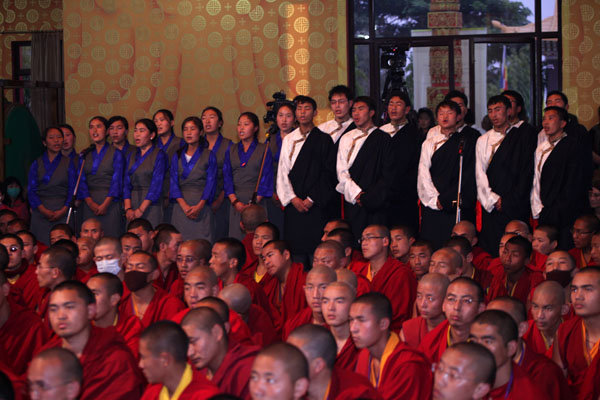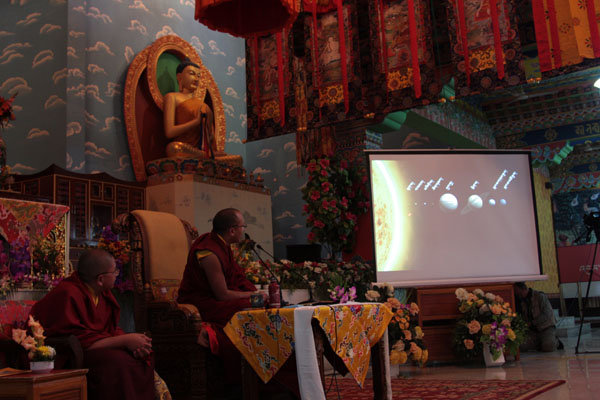法王新闻 | 2009年12月
針對《環境保育議題》給予開示
Gyalwang Karmapa Launches Official Website for Environmental Protection: Khoryug.com

時間:2009年12月22日下午 22 Dec., 2009
地點:印度 菩提迦耶 德噶寺 Tergar Monastery in Bodhigaya, India
中文翻譯:堪布丹傑
報導:黃靖雅
攝影:噶瑪善治、噶瑪諾布
法王用powerpoint,直指空性!
法王用powerpoint,從一片樹葉,漸次拉遠到十萬光年的太空,
再拉近到物質最基礎的夸克內部,帶大家看見「空性」。
(大眾唱頌〈金剛總持祈請文〉)
環保會議上,法王 「直指空性」?
沒錯,而且法王這位現代上師,還運用powerpoint幻燈片播放技術當教具,讓空性「看得見」!
今天(12月22日)下午3:00,在印度菩提迦耶德噶寺召開、以僧眾為主體的「噶舉各寺院環保會議」中,法王親自製作幻燈片教材,運用電腦的powerpoint功能,帶大家「上窮碧落」,引導大家的視覺和想像力從一院綠樹漸次飛上天空,拉遠再拉遠,宏觀再宏觀,最後終於看不見自己安身立命的地球;然後再鑽入一片樹葉的內部,拉近再拉近,微觀再微觀,最後到組成物質最基礎的成分:夸克(就是佛家說的「微塵」),然後再鑽入夸克,會發現什麼都沒有了……最後一張幻燈片寫著:空性!
這是一場環保教學,但也是一場很有創意的「空性」開示。除了法王的幽默,和擅長運用現代工具教學,令人印象深刻;更重要的是,法王希望在這支教學幻燈片中傳達的訊息:我們常自我膨脹,以為自己是宇宙的主人,其實在浩瀚無際的太空中,我們所依的地球,其實微不足道,比起廣大的宇宙,我們應該謙卑;我們總是執以為實,以為自己和萬物都是真實存在,但以一片葉子為例,深入微觀,會發現事物真的是「空性」的,追到最後,了不可得,希望減淡我們「執以為實」的感覺。
希望眾生離苦得樂,有願就要有行動!
法王開示:我們修持佛法,都說希望幫助一切眾生離開痛苦、得到快樂,雖然這樣發願,但卻經常沒辦法如自己的祈願那樣做,為什麼這樣呢?為什麼有善願,卻沒行動,甚至做相反的事呢?因為我們有一種錯誤的觀念,覺得凡是我想要的都要去擁有,這只是我執,因為有強烈的自他分別,覺得照顧好自己就行了,不必管別人;但其實,如果別人不管我們,我們就死了!連呼吸,我們也沒辦法只靠自己,連最基本的呼吸一口氣,都需要樹,而樹需要陽光、空氣、水,自己真的沒辦法製造呼吸所需要的全部因緣。我們常以為自己是宇宙的中心,宇宙的主宰,但事實上我們都要依靠別人、依靠地球而存在。
現在我們每天會聽到很多自然災害新聞,有水災、風災、旱災、海嘯等,其中至少有百分之五十、甚至有百分之七十是人類自己造成的。如果我們發願幫眾生離苦得樂,想承擔幫地球上一切生命,不只人類,解脫痛苦和恐懼的責任,那麼環境保育就是我們應該做的。
守護地球,這有情生存的珍貴所依
這是地球(法王以光筆指幻燈片布幕),我們居住的地球,70%都是水,所以從遠處看會是綠色的。這是太陽系,有九個行星,水星、火星、土星等都在那兒了,我們是最大的嗎?不是,太陽系行星中,土星最大,是地球1300倍,但這個不大的地球,和太陽的距離剛剛好,不近也不遠,正好可以生成萬物,讓我們居住,多麼珍貴難得啊。
這是銀河系,一個銀河系有兩百億個太陽,如果打一個手電筒,從一端到另一端,要十萬光年,那時我們早就死了,我們抬頭可以看見燦爛的星星,但其實那些星星早就死了,但因為曾發出光亮,現在還閃亮著。像我們這樣的銀河系有多少個呢?有科學家說有九千億個,到底有多少個銀河系?有人說,就算地球上的沙全部數目加起來,還比不上宇宙的星球數。至於究竟多少?我喜歡佛家的說法,因為太多了,乾脆說「不可思議」。
接著,我要「直指空性」給你們看哦。(法王開始一張張播放圖片)這是庭院的樹,這是十公尺外的高空看到的樹,然後一公里外,十公里外 ,一萬公里外……十的十七次方是一光年,到一百萬光年,連銀河系都只剩一個小光點,地球更是完全看不見了。剛剛是拉遠看,接著,我們要反個方向拉近看,這是一片樹葉,這是縮小十倍的,一百倍的……一直到十的負14次方,夸克內部,就是「空性」了。
人類只是地球兩百萬種物種其中一種,卻對養育了兩百萬種生命的地球,使用過度,讓資源有枯竭危機,環境有崩解警訊,豈不是因為自私而害到自己?有些宇宙是共業所成,有些是加持所成,有些是願力所成,這個共業所成的地球,我們要好好守護。地球忍護一切,守護一切,即使是眾所鄙棄的惡人,地球也無私地接納,但如果傷害她,我們就一無所依了,請大家守護!
由於這是一項環保會議,所以在法王開示之前,先由「環境保護」主要負責人德基女士致辭,她也以幻燈片形式配合報告,接下來由喇嘛戛桑報告噶舉各寺院在各所在社區執行環保的實際做法:
德基報告:五項重點,108個方去
地球有兩百種物種,人只是其中一種。我為世界野生基金會工作,知道目前地球上有十九有生存危機的物種,來自三個西藏高地。為什麼西藏的環境保護這麼重要,因為三種高地都在西藏。 西藏的冰河對全世界的水源,都是很重要的源頭,長江、黃河等亞洲主要河川的來源,都來自西藏。現在西藏氣候變化的速度是十倍速變遷,在一些不該有蚊子的地方也有了,這是個警訊,顯示地球環境的變化。很多冰河都已經消失了,從1968年和 2008年兩張照片對比,就可以發現嚴重性。在喜瑪拉雅山麓,也發生了冰河溶化的洪災。人類這種單一物種,對資源的過度使用方式,引起了氣候變遷。
前陣子在哥本哈根有一項全球氣候會議,但沒有達成任何協議。其實環境保育這並不是由政府主導形成一個決議就行,成不成功,都是取決於我們每個個人。法王噶瑪巴也提醒,這都是我們每個寺院、每個僧眾的責任。
這是一個表格,詳列各寺院可以如何協助減緩氣候惡化。法王曾說,我們必作為模範。但了解問題在哪裡是第一步,我們都是社區的一部分,了解我們那個社區最迫切的環保問題是什麼,才能對症下藥,對社區提供最好的環保協助。為此,我們成立了一個「自然環境保育組織」,可以讓我們為環境保育實際做點事,如果有人還沒參加,應該馬上參加。
兩年前,我被徵召來為噶舉做一個環保計畫。法王說必須包括,水資源、森林、野生動物、廢棄物處理等五項。法王要求我們要將環保手冊翻譯成更多語言。在鹿野苑舉行環保會議中,有許多寺院參加,我們總結了108 項方法來保護環境,各寺院請求成立組織,十月召開會議,重點在各寺院可以實際採取什麼行動,如去察看水源地是如何變枯竭的。由於法王的慈悲和遠見,所以同意成立「自然環境保育組織」,這個組織,不只噶舉派寺院參加,格魯派也有寺院表示希望加入。
我們也和「守護地球」組織合作,會在正覺大塔前,播放環保教育影片,我們要清理德噶寺四周,也會清理市場。我們也剛獲得比哈爾省政府同意,在Gaya機場種樹,由德噶寺贊助,作為迴向法王長壽住世。
喇嘛戛桑報告:知足,是最好的環保
這次在菩提迦耶召開的環保會議,感謝法王和蔣貢康楚仁波切蒞臨現場指導。
這個組織名稱藏文叫「扣優」,即環境之意。今天主要報告,在不丹、尼泊爾、西藏等各噶舉寺院,實行環境保育的情形。
法王不分畫夜地為眾生的苦樂擔憂,要我們要在還來得及時,趕快為地球做些事情,未來才不會後悔。法王提醒我們:這個地球如此美麗,承載我們的生活,提供我們食衣住行,這麼一個珍貴的地方,如果現在不好好保護,未來的孩子還能居住下去嗎?「這種地球面臨的氣候危機,都是人類自己的貪欲自己造成的。」當我們在鹿野苑,聽到法王這麼說,好像臉上被打了一巴掌。那要如何實行?法王給了108條規則,已經翻譯成尼泊爾文、不丹文、德文等多國語文,各寺院所在地的居民們,對寺院實行環保,也都很高興,表示歡迎。竹奔仁波切也希望趁這次祈願法會,這麼多人來這裡,讓更多人知道,投入去做。
當我們了解環境保育的重要性後,具體應該如何去做?可分成以下部分:
一、森林保育:有生命的生物想生存下去,能不能好好呼吸是關鍵,所以森林保育非常重要,有些寺院種了一百棵以上的樹,有些租地種樹,有些則種樹之後,分配給喇嘛照顧。
二、水資源保護:水也是生存的必需品,此外地球越來越熱,對水的需求也更大,所以各寺院對水資源的保護也做了一些事:有些寺院特別保護水源地不被污染,打掃乾淨;有些則是污水不亂排放,或過濾之後再排放;有些則盡量多次使用,如洗完澡的水,拿去澆花澆菜。
三、能源使用:多使用油電以外的替代能源,譬如使用太陽能的熱水器。
四、廢棄物處理:垃圾方面,我們準備了許多不同材質的垃圾筒,給各寺院做垃圾分類用。有些針對玻璃瓶和塑膠用品作回收,有些政府獎勵回收,寺院還因此多了一筆收入。此外,廚餘收集去作肥料,取代化學肥料,有些寺院反而吃得更好,僧眾也更健康了;也有用廚餘種樹。還有,我們買東西送的塑膠袋,也要少拿少用,因為它非常不易分解,對環境是長期的負擔;有些寺院還剪破布做袋子,減少使用塑膠袋的機率。最主要是要知足,減少物慾,少買不必要的東西,從根本做起,就像法王說的,「知足,是最好的環保」。
今天本來應讓到場的各寺院代表,報告各自做了什麼事,但因時間之故,由我代表整體報告。有人問我,這些是聽說的,還是真的看到了?前陣子我奉法王之命到各寺院視察僧眾威儀時,看到各寺院真的對環保有了一些實際的做法,所以這些,真的不是談談而已。
我們也相信不只寺院,全世界各中心、各團體,在法王帶領下,也都能一起來作環保,為世界環境保育作努力。
(法王開示後,舉行「環境保育網站」開幕儀式,請法王啟動使用儀式,法王點選進入首頁 http://www.khoryug.com ,再點入環保開示影片)

This afternoon, in the packed assembly hall of Tergar Monastery, His Holiness the Gyalwang Karmapa formally launched www.khoryug.com, a Tibetan and English-language website dedicated to environmental protection. The website offers educational resources on environmental protection, news on environmental projects underway in Kagyu monasteries and nunneries, and offers a forum for people interested in the environment. Khoryug.com forms part of a larger series of projects that His Holiness has undertaken to protect the earth for future generations, goals for which will eventually restore the natural environment of Tibet and the Himalayan areas. As such, khoryug.com follows the emerging pattern of the activities of the 17th Gyalwang Karmapa, to work for the well-being of others in ways that are both immeasurably vast and yet eminently practical.
The event opened with a presentation by Dekila Chungyalpa, Director of the Greater Mekong area for the World Wildlife Foundation (WWF) – the single largest organization devoted to environmental protection in the world. Dekila has served His Holiness as coordinator for his activities to protect the environment, and she stressed the importance of geographical areas that are part of the larger Tibetan cultural zone. She noted that three of the 19 areas in the world chosen for special attention by the WWF, for their value in terms of biodiversity, fall within Tibet and the Himalayan region. The rate of change in Tibetan and the Himalayan areas is ten times faster than elsewhere, with glaciers visibly melting from year to year. In addition, the mountains of this area are the source of rivers that support millions of people. As such, the environmental condition of Tibet and the Himalayas has particularly far-reaching consequences. Dekila described a number of projects that participants in the Kagyu Monlam can participate in to clean the environment around Bodhgaya itself.
Khenpo Kelsang Nyima from Rumtek spoke next, commenting on the experience that many of the Tibetan monastics had when attending the first environmental conference convened by His Holiness in March 2009 in Varanasi. “His Holiness led us to see,” he said, “how beautiful a place the world is.” He further emphasized that His Holiness had impressed on the monastics present that “we humans have created the problem, through our greed, and must take responsibility for solving it.” Khenpo Kelsang Nyima praised His Holiness for his constant and far-reaching concern for others and for, not only caring for those in the present, anticipating dangers in the future and working proactively to avert them. The Khenpo then offered a report on the practical steps taken by the Kagyu monasteries and nunneries to work for their own local environments. A wide range of projects were implemented, including cleaning water sources, planting trees, separating waste and recycling, composting, installing solar heaters, converting to low-energy bulbs, ending the use of plastic bags and bottles, and much more.
Next to speak was the Gyalwang Karmapa himself. His Holiness presented the need to work for the environment as a logical extension of our Dharma practice, connecting it to our Mahayana commitment to benefit others, and to live in a way that is consistent with the basic fact of interdependence.
In a powerful address, His Holiness urged the audience to ask themselves whether the beautiful aspirations and prayers they make in the morning are carried out in their actions throughout the day. Often when opportunities arise to work to benefit others, we do not seize them, and if we ask ourselves why this is so, it is usually because we are simply working for our own egocentric concerns. “Too often we behave as if others existed for us, and as if the Earth was ours alone to use as we wish,” His Holiness said, “and our actions based on such attitudes have had cumulative effects that are devastating for the Earth itself.”
Drawing on the point made earlier by Dekila, that we humans are but one of the immense number of species of life on this planet: His Holiness added that we, nevertheless, dominate the planet as if it were ours alone, and we are responsible for virtually all the damage done to it. His Holiness emphasized that this attitude is inappropriate as well as damaging given our total dependence on others, and especially on the earth itself, for our well-being and for our very survival. The Gyalwang Karmapa noted that without the plants that yield oxygen, we would not even be able to draw a single breath.
Using a Powerpoint presentation to underscore his points with images, His Holiness took the audience on a dazzling tour of the galaxy, pointing out along the way that we humans have nowhere else to go if we destroy the earth’s natural environment.
“Yet unlike humans, the earth is endlessly forgiving,” His Holiness noted.
“When someone commits heinous crimes, such as murder, he is shunned and expelled from human society. Yet however much harm we do to her, the Earth never banishes us. Despite all the damage we have done thus far, she has never given up on us, but continues to yield her resources to us with great generosity. We, therefore, all have a responsibility to consider what practical steps we can do to respond in kind to this great kindness that we receive from the Earth.”
The event concluded with a moving rendition of the song Aspiration for the World, composed by His Holiness himself and sung by a chorus of students from the Tibetan Children’s Village School.
Although the primary audience for the presentation were Tibetan monks and nuns, translators were on hand to deliver the message to the international audience in nine different languages. Many were in Bodhgaya to attend the upcoming Kagyu Monlam and the annual winter teachings for foreign students. For these students, the focus on taking steps to care for the environment, as an extension of Dharma practice, had a particular poignancy. One student from Mexico, visiting India for the first time, commented afterwards: one of the most pressing questions she had, from her stay in Bodhgaya thus far, was” how to respond practically to the great pain and suffering visible all around?” With His Holiness’ message on environmental protection, as a way to take care for others, and the upcoming projects to work directly to clean the local environment in Bodhgaya, “her question is answered,” she said.
Gyalwang Karmapa Launches Official Website for Environmental Protection: Khoryug.com
网页修改记录:2020年12月24日,新建网页;2024年2月14日,网页地址和版面略作修改。
